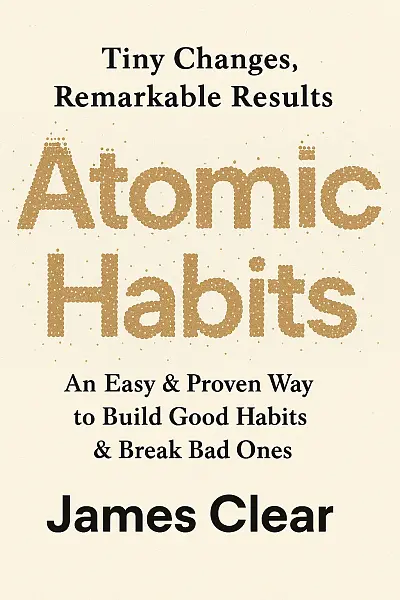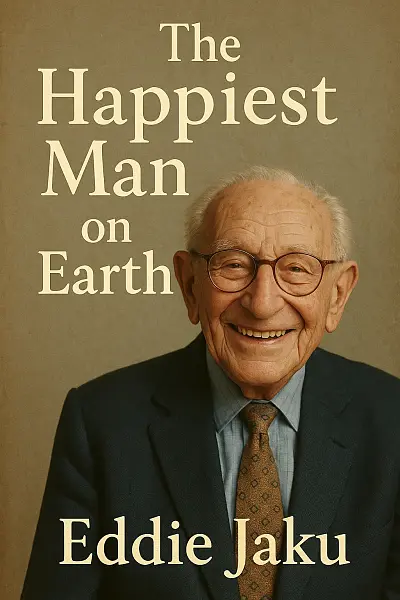
Atomic Habits: An Easy & Proven Way to Build Good Habits & Break Bad Ones
by: James Clear
James Clear feels trapped by frustrating cycles of failed resolutions and unfulfilled ambitions in the hustle of modern life. Everything shifts when he realizes—it's not about willpower, but about systems.
Determined to gain control, James dives into the science of behavior, wrestling with the daunting challenge of transforming tiny daily actions into lasting change. Each small improvement carries high emotional stakes: confidence, health, even identity hang in the balance if he can’t figure this out.
With a warm, no-nonsense style, Atomic Habits invites readers into a relatable, practical journey—will these micro-changes add up to real transformation?
"Lasting change is crafted not by grand gestures, but by the quiet persistence of daily choices."
Literary Analysis
Writing Style
Atmosphere
- Energizing and optimistic, radiating a can-do spirit that feels inviting rather than intimidating
- Modern and down-to-earth vibe, with a focus on practicality
- Lively momentum — the book feels like a motivational coach constantly in your corner
- Never preachy; instead, it fosters an atmosphere of encouragement and approachability
Prose Style
- Super clear and conversational — James Clear definitely lives up to his name
- Short, punchy sentences with a knack for getting straight to the point
- Relies on relatable anecdotes, memorable metaphors, and actionable takeaways
- Friendly rather than formal — you'll feel like you're chatting with a savvy friend over coffee
- Complex ideas broken into bite-sized chunks, with frequent summaries and handy visuals
Pacing
- Brisk and invigorating, never lagging or bogged down by jargon
- Chapters are brief, with clear transitions and zero filler, making it easy to dip in and out
- Practical tips are woven throughout, ensuring you’re constantly getting something useful
- Each idea builds logically on the last, maintaining steady forward movement without overwhelming you
Mood and Feel
- Encouraging, solution-focused, and decidedly nonjudgmental
- Strikes a balance between scientific authority and relatable storytelling
- Leaves the reader feeling empowered, like change is not only possible but totally doable
- The tone is light yet never frivolous — it's all about making lasting change feel genuinely accessible
Overall Impression
Expect a no-nonsense, motivating guide that’s easy to read, packed with real-world stories, and laser-focused on helping you make tiny changes that add up to something big — all delivered in a voice that feels equal parts expert, coach, and friend.
Key Takeaways
- Tiny changes, massive results—the central mantra that flips conventional self-help on its head
- "Identity-based habits"—that killer aha moment: act like who you want to become, not just what you want to achieve
- Cue. Craving. Response. Reward.—habit loops stripped down to a snappy, memorable system
- The Plateau of Latent Potential—Clear’s brutally honest chart showing why progress feels invisible before it explodes
- The Two-Minute Rule: making habits laughably easy to start—and sneakily addictive
- Stories of Olympic gold and real-world fails—inspiring case studies that prove brains (not willpower) win the day
- Clear’s breezy, no-BS prose—packed with visuals, real talk, and those punchy chapter summaries you’ll actually use

Tiny changes, remarkable results—habits mastered for real-life success.
Reader Insights
Who Should Read This
If you’re the kind of person who loves self-improvement, productivity hacks, or any kind of “life upgrade” advice, Atomic Habits is totally your jam. Whether you geek out over habit trackers, bullet journals, or just enjoy books that give you practical steps (not just pep talks), you’ll find so much to love here. It’s perfect for folks who want to see actual results from their efforts—whether you’ve got a big goal like writing a novel, getting fitter, or just want to stop doomscrolling every night.
Honestly, if you gravitate towards books by people like Charles Duhigg (The Power of Habit) or Cal Newport (Deep Work), this one fits right into your wheelhouse. Think of it as a toolbox for anyone feeling stuck, easily distracted, or just ready to shake up their daily routine in a real way. And if you might be a bit skeptical when it comes to “change your life in 30 days” promises, the good news is: James Clear is down-to-earth and backed by science, not woo-woo hype.
Who will especially vibe with it:
- Lovers of personal development and self-help books
- Busy people hunting for quick wins and real-world strategies
- Anyone who gets fired up by small changes adding up to big results
- Folks who’ve tried to make changes before but need a clear, no-nonsense framework
- Fans of approachable, easy-to-understand writing with lots of actionable takeaways
Who might want to skip it (or just borrow a friend’s copy):
- Readers who prefer deep, nuanced storytelling over practical tips—this isn’t narrative nonfiction or memoir
- Anyone looking for dense academic theory—it definitely leans more “how-to” than “why things work”
- People who already have a solid habit system and aren’t really looking for tweaks
- If self-help or behavioral science just isn’t your thing, this one probably won’t change your mind
Bottom line: If you like your advice clear and your steps actionable, with just enough story to keep things interesting, you’ll get a lot out of Atomic Habits. But if you’re after something more literary or abstract, this probably isn’t going to hit the sweet spot.
Story Overview
Ready to finally make habits stick? Atomic Habits by James Clear dives into the science and psychology of small changes, showing how tiny tweaks in your everyday routine can lead to remarkable results. You'll follow stories and examples of real people as they wrestle with breaking old patterns and building lasting habits, all packed into crisp, actionable steps that feel totally doable. This book is practical, uplifting, and gives you a toolbox to tackle your own self-improvement goals—without any guilt trips or overwhelming advice!
Main Characters
-
James Clear: The author and central voice, he blends personal anecdotes and scientific research to guide readers through the process of building better habits. His relatable storytelling makes complex ideas feel accessible and actionable.
-
The Reader: Cast as the main "character" on a transformative journey, the reader is prompted to reflect on their own behaviors and actively participate in habit change throughout the book.
-
The British Cyclists: Featured as a key real-life example, this team’s dramatic improvement through tiny habit changes illustrates the powerful impact of small, consistent actions. Their story is used to inspire and motivate.
-
Clear’s Clients and Case Studies: Woven throughout, these recurring figures serve as practical examples of ordinary people overcoming challenges and redesigning their habits, offering a diverse range of perspectives and successes.
-
Habit Loop (Cue, Craving, Response, Reward): While not characters in the traditional sense, this framework is treated like an ever-present guide that shapes every step of the habit formation journey, almost taking on its own personality within the narrative.
If You Loved This Book
If you've ever been inspired by The Power of Habit by Charles Duhigg, you'll instantly vibe with Atomic Habits. Both books explore the science of human behavior, but James Clear’s approach feels more actionable, breaking down self-improvement into bite-sized, doable steps rather than grand, sweeping theories. Readers who prefer a more tactical, hands-on guide to making change will find Clear’s methods refreshingly practical compared to Duhigg's more narrative-driven style.
Fans of Tiny Habits by BJ Fogg will notice a kindred spirit here, yet Clear’s tone is a bit more straightforward and his framework more visually memorable. While Fogg delves into how emotions and celebration reinforce micro-changes, Clear leans into the power of identity and the compounding effect of making small choices consistently. Both celebrate starting small, but Clear’s examples and diagrams offer a slightly more structured roadmap for habit formation.
And for anyone who loves a good transformation story like we see in the TV series Queer Eye, Atomic Habits echoes that same spark of hope—just swap out home and fashion makeovers for everyday routines and mindset shifts. Watching the Fab Five help someone change their life in small, meaningful ways feels remarkably similar to the empowering, incremental progress Clear champions in his book.
Expert Review
Imagine if every tiny choice you made—brushing your teeth, sending a quick email, skipping the gym—compounded into a force that quietly guides your destiny. Can the architecture of our habits truly shape our fate, or are we prisoners of willpower? Atomic Habits by James Clear hurls this question into our mainstream consciousness, offering a blueprint for self-renewal in small, stubborn increments.
James Clear’s voice throughoutAtomic Habits is a study in accessible precision—structured, friendly, and refreshingly jargon-free. Each chapter unfolds with a crisp narrative rhythm, employing engaging anecdotes—Olympic athletes, comedians, and business leaders—to illustrate how minuscule behavioral shifts can trigger outsized transformation. The prose is clear (pun intended), with subtle rhetorical flourishes that invite the reader rather than overwhelm them. Rather than prescriptive lectures, Clear opts for conversational directness, distilling complex behavioral science into actionable steps. The book’s signature framework—the Four Laws of Behavior Change—benefits from this clarity, avoiding theoretical abstraction in favor of memorable, bite-sized advice.
What sets Clear’s style apart is his practical empathy. He anticipates common reader frustrations and gently dismantles self-blame, repositioning “failure” as a systems problem rather than a flaw in character. Visual metaphors (like the “plateau of latent potential”) stick with you, supporting his pragmatic optimism. The writing, however, sometimes leans on repetition; concepts like “identity-based habits” are emphasized so persistently they risk diluting their initial impact. Yet this redundancy can cement learning, especially for readers dipping in and out.
At its core, the book champions the idea that profound change is an accumulation of microscopic decisions—a riposte to our obsession with quick fixes and grand resolutions. Clear interrogates the seductive myth of motivation, arguing instead for humble, structural interventions: environmental design, habit stacking, identity shift. These are not just personal productivity hacks, but speak to larger cultural anxieties—burnout, focus, self-mastery—in an era of relentless distraction.
One of the book’s most resonant ideas is that systems trump goals, challenging the goal-fixated culture that dominates both workplaces and self-help literature. Clear’s method is powered by a belief in agency—not as an act of brute force, but as the outcome of engineering small wins into our daily routines. It’s a philosophy aligned with cognitive behavioral psychology and neuroscience, yet delivered with warmth that democratizes the science.
Within the crowded genre of habit change and productivity, Atomic Habits distinguishes itself by fusing rigorous science with everyday wisdom. Compared to Charles Duhigg’s The Power of Habit or Gretchen Rubin’s Better Than Before, Clear’s work is more granular and actionable, with a keen eye for what derails ordinary people. It sits at the intersection of self-improvement and behavioral economics, but never forgets the reader’s messy reality.
Is it flawless? Not quite—the repetition can be wearying, and skeptics may crave more empirical skepticism or broader cultural critique. At times, the book’s optimism risks glossing over systemic barriers outside individual control. Yet its warm pragmatism and vivid accessibility mean Atomic Habits earns its global following. For anyone seeking meaningful, sustainable change, this book isn’t just timely—it’s indispensable.
Community Reviews
i thought i'd breeze through this, but that part about "you do not rise to the level of your goals, you fall to the level of your systems" kept echoing in my head and honestly, i had to put the book down and rethink everything.
i almost tossed this book aside, but then that bit about "you don't rise to the level of your goals, you fall to the level of your systems" hit me like a brick. now i can't stop tweaking my habits. worth finishing.
i started this book thinking it was another boring self-help manual, but the part about "you do not rise to the level of your goals, you fall to the level of your systems" just would not leave my head. kept repeating it all week.
was NOT prepared for how many times james clear would sneak up behind my brain with "you do not rise to the level of your goals, you fall to the level of your systems" and now i see habits lurking in every corner of my life
couldn't stop thinking about the line "you do not rise to the level of your goals, you fall to the level of your systems" like it echoed in my brain at 2am and made me rethink my entire approach to habits.
Cultural Context & Discussion
Local Perspective
James Clear’s Atomic Habits absolutely strikes a chord with readers in the context of American culture.
There are so many fascinating layers here:
- The book’s obsession with self-improvement echoes deeply held American ideals about personal agency and reinvention—think the “self-made” myth that’s been core to the U.S. since the days of Ben Franklin and the postwar boom.
- Its stress on incremental change fits beautifully alongside the Protestant work ethic: slow, steady progress, hustle, and discipline have always been celebrated here.
- Atomic Habits landed during a surge of “life hacking” fever—readers, shaped by Silicon Valley optimism and social movements like minimalism, are primed to love concrete, productivity-boosting systems.
But there’s a twist!
- The book nudges against America’s “go big or go home” mindset, gently challenging the need for overnight transformation, and that subtle rebellion might be why it feels so refreshing—and attainable—to so many readers.
- Unlike the usual “hero’s journey” of many American literary classics, Clear favors habit and community over charismatic individuals—an unexpectedly communal approach in a very individualist culture!
Points of Discussion
Notable Achievement & Cultural Impact
Atomic Habits by James Clear has become a massive global bestseller, selling over 15 million copies and consistently ranking at the top of self-help charts. It's widely praised for making behavioral science and habit formation accessible to everyday readers, and its "Four Laws of Behavior Change" have influenced countless individuals, businesses, and organizations aiming for personal and professional growth.







